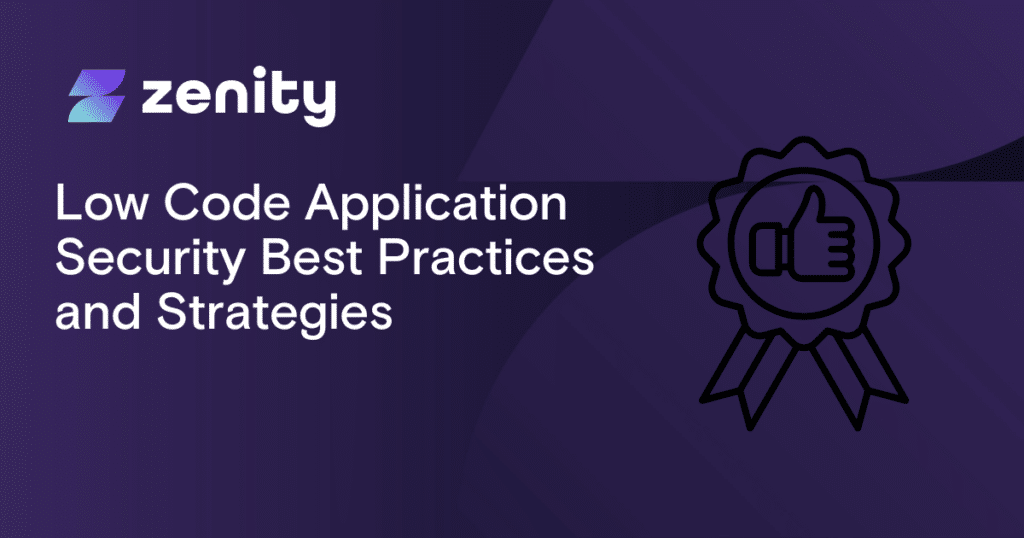Low-Code vs No-Code: Is There a Difference?

For organizations to be more productive and agile in their development processes, understanding the core differences between low-code and no-code applications and platforms is vital. In this article, we take a closer look at low-code vs no-code, explore the benefits of each, and explain how design flaws and security vulnerabilities in these environments are addressed.
What are Low-Code and No-Code Development Platforms?

Low-code and no-code, although similar on the surface, do in fact differ considerably. While low-code and no-code both support application and automation creation via an intuitive drag & drop based UI, low-code also has granular controls designed for skilled developers who are proficient in writing code for various programming languages, cloud services, and existing business processes.
The no-code movement is a relative newcomer to the scene and is causing disruption in the industry. No-code is a hugely popular and entirely visual approach to programming. No-code services provide access to predefined coding environmental options that can literally be dragged and dropped into a workflow to build an application.
It is typical that non-technical workers such as marketers, business analysts, office admin, and small business owners start out using no-code solutions to create simple solutions, and then, as they become more skilled and confident, switch over to low-code.
Fast is Never Fast Enough
Since the turn of the millennium, traditional coding has flourished as Java, C#, JavaScript, Python, and many more programming languages have taken center stage. However, no programming language is perfect, and businesses who are deeply embedded in traditional coding practices are realizing that managing code at scale can prove to be very difficult, particularly when maintaining code between different teams.
All developers write and maintain code in different ways, even when businesses attempt to enforce code standards. Furthermore, writing traditional code can be a slow and cumbersome process, often taking months or years to fine-tune complex implementations and involving substantial manpower for code reviews, testing, deployments, and maintenance.
As a result, there has been a gradual shift towards low-code in recent years. This uptake created noticeable increases in productivity with the introduction of IDEs and source control. But for many, this is still not fast enough. Cloud computing has enabled businesses to rapidly deploy services in minutes and this ability is feeding an insatiable desire to have code ready and deployed instantly.
And this is where no-code comes in – a solution that requires minimal development skills to write and deploy. The idea of no-code is intertwined with the DevOps mentality that simple code should be instantly available for deployment. Instead of reusing low-code software repositories, no-code is typically a software-as-a-service (SaaS) offering that enables the creation of applications by users with no prior knowledge of programming languages, machine code, or platform development.
No-code users navigate a visual platform to build simple applications. Non-technical users can drag and drop a design process to create apps and automations that help them deal with cumbersome manual tasks, as well as be able and offer new digital services.
There are very good reasons for using both types of platforms, as is evident in these low-code examples. Let’s take a high level look at the benefits of using low-code before we examine the benefits of using no-code.
We’ve created a comparison chart that demonstrates what we believe are the benefits of each approach to development:
| Low-Code Development | No-Code Development |
|---|---|
| Applications can be created with minimal coding needed. | Applications can be created with absolutely no coding required. |
| Great scalability options. | Very limited scalability options. |
| Knowledge of programming languages is required. | No programming skills are needed, everything is created visually. |
| Integration with any existing backend services requires developers to build application hooks. | Integration is only available with a limited selection of pre-defined application hooks. |
| Designed for businesses that already have skilled developers. | Applications can be created by anyone, no knowledge of coding is required. |
| The time to first build is fast however integrations can slow the process down significantly. | The time to first build is extremely fast, often testing and go-live can happen immediately. |
| Making changes to existing code may involve lengthy changes to integrated services. | Making changes is rapid via the user interface. |
They both give businesses the opportunity to develop right now without having to hire expensive contractors or recruit seasoned developers.
Alleviating Security Concerns for Low-Code and No-Code Development with Zenity
The good news is that low-code/no-code platforms can reduce application development time, which allows organizations to be more productive and agile in their development processes. Gartner even expects over 70% of application development to be on low-code/no-code development practices by 2025.
applications. Like any application, low-code/no-code applications can have design flaws and security vulnerabilities. Some of these risks, such as unpatched hosts, or code vulnerabilities in the low-code/no-code platform itself, should be managed by the low-code/no-code platform provider, but others, like applications or automations that implement insecure business logics that could leak sensitive business data, introduce supply-chain vulnerabilities, or open a door to ransomware and compliance breaches fall to users to address.
That’s why low-code/no-code applications follow a shared responsibility model for everyday operations, wherein ownership for security and functionality is shared between the customer and the service provider. The service provider has a duty of care to ensure the platform is robust, secure and hardened against all the latest threats, and the customer is responsible for creating low-code/no-code applications with business logics that follow security best practices and protect their organization and data.
With the rapid growth of low-code and no-code platforms, traditional security processes based on security reviews cannot scale to match the rapid growth in application development, and the existing tools are inadequate. The tens of thousands of applications developed by business and pro users each year can contain numerous vulnerabilities and insecure patterns, such that can expose organizations to data leakage, supply-chain attacks and ransomware.
Zenity enables scalable security by continously of identifying security flaws in low-code and no-code applications. By analyzing every business logic and component separately, Zenity enables IT and security professionals to gain vital visibility and control, enabling them to manage a governance process, and rapidly remediate security violations in their organization’s applications and automations.
Both low-code and no-code have the same promise and introduce similar risks, thus they are covered by one solution – Zenity. You’re welcome to sign up for a free demo: https://www.zenity.io/book-a-demo/


